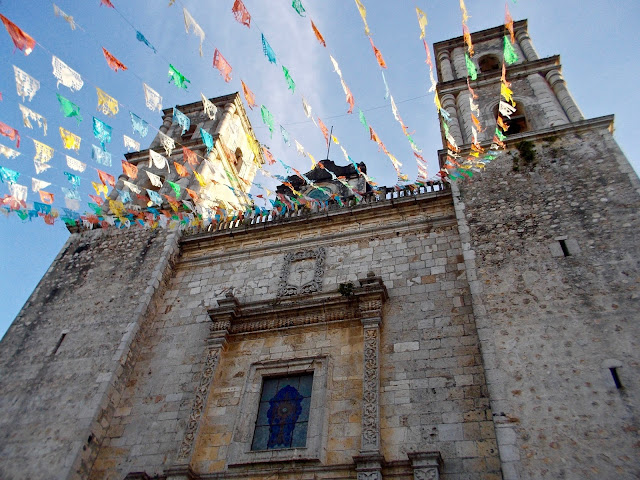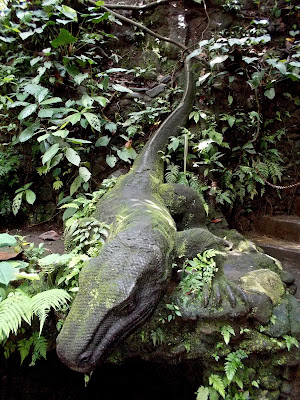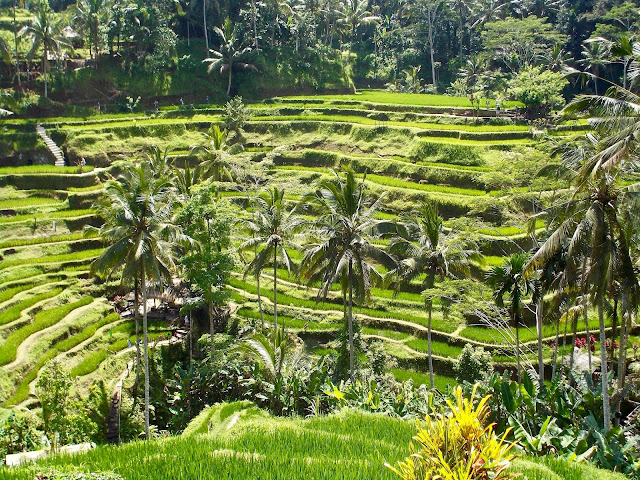October 18 -25, 2017
I was apprehensive about returning to Bali after 40 years. Since those early visits, it had become such a tourist destination that I was afraid it would have lost much of what had appealed to me back when Sanur Beach had the only western-style hotel on the island and we had stayed in a rented room in a family compound with no fans or A/C and no running water.
This time, we avoided the beach areas and took a taxi directly to Ubud from the airport. We had booked into Sama's Cottages, which proved to be a good choice. Though close to the main thoroughfare, it was leafy and quiet with lovely en-suite rooms dotted among the gardens and pleasant staff who enjoyed my rusty conversation in their language. The entrance was narrow but welcoming.
A long passageway opened into a courtyard with reception desk behind a small pond teeming with koi.
Each cottage was separated from the others by tropical plants, some of them with spectacular flowers.
Since we kept extending our stay, we had to move rooms three times. All were good, but No. 3 was our favourite.
Although Ubud was no longer the one unpaved street of small houses I remembered, it still had much appeal, largely because the local people seemed to take the influx of foreigners in their stride, catering to the expectations of the modern traveller while still going about their traditional practices as if we were not there. Their serenity and tolerance is enviable.
Many store owners still place offerings to their gods on the sidewalk outside, which visitors carefully avoid and the Balinese simply walk over. To the latter, it's the act of making the offering that's important; what happens to it after that is irrelevant.
Along with the flowers, these offerings often included candy bars and even cigarettes.
We went, as everyone does, to the Monkey Forest, a 20-minute walk from our accommodation on streets crowded with people. After paying attention to the warning sign at the entrance,
... we wandered along the well-groomed paths, seeing many monkeys of all sizes, most of them moving so continually that it's hard to get a photo that isn't blurry..
I'm not that fond of monkeys, so I preferred some of the still life, particularly the skilfully placed sculptures.
For the rest of our week-long stay, we divided our time between walks in the vicinity of Ubud and two days of renting a car and driver to take us to more far-flung destinations.
The commercial heart of Ubud is tightly centred around a few streets. Outside that area, the terrain quickly becomes rice paddies and palm trees. Our first walk took us on a long, hot hike into this lush green landscape, dotted with small shrines and thatched cottages.

Where the rice had been harvested already, brown ducks motored around, blending with the brown water.
Our second walk a couple of days later was shorter, but more interesting with a more varied landscape and glimpses of local people tending their harvest.

There were also more places to stop for a cool drink on this walk, some of them with a view over the surrounding sawah (ricefields.)
While we would have preferred to visit other sights on local buses, that's still not easy and getting between places can take a lot of time. If we'd been staying longer, we might have attempted it, but hiring a car and driver allowed us to travel considerable distances and see some impressive sights.
Our first visit was to Taman Ayun, a collection of temples reached across a large lake filled with lotus.
I was intrigued by the unusual fruits on a tree in the inner courtyard. About the size of coconuts, they clustered thickly on the trunk rather than hanging from the branches.
There were at least as many Balinese visiting here as there were foreigners.
The temples themselves are clustered within a courtyard open only to worshippers, but we could admire them across the low stone walls.
At one point, we could see a mother praying with her young son.
From there we headed down to the south coast to see Tanah Lot, another temple perched on a rocky islet. Tourists are encouraged to visit at sunset, but we found it pretty impressive at midday too.
There are several open-air restaurants in strategic viewing places along the mainland shore and the grounds are beautifully, and in some cases inventively, landscaped
For a change of pace, we continued on to the spectacular Jatiluwih rice terraces. We had hoped to have time for a walk along the dikes, but arrived a bit too late in the afternoon, with a cool mist starting to come down from the higher ground.
A diversion en route had included a visit to a coffee and spices establishment where we saw coffee being roasted,
... and met a luwak, or mongoose.
These creatures are fed coffee beans, which are collected after they are excreted and processed into what we were told was "the most expensive coffee in the world". We tasted a small cup of this and I have to admit that it just tasted like ordinary strong coffee to me. Clearly I'm not a connoisseur.
One other diversion took us to a jewellery and batik factory, where we could watch young women fashioning delicate designs with fine silver wire or drawing wax patterns on cloth in the traditional way.
Our second day of touring around started well with a better driver who gave us a lot of insight into Balinese customs and religions as we drove. And his name was Karma!
With him we visited more rice terraces at Tegalalang.
These were in a much more confined space than the Jatiluwih terraces and less dramatic. Also, being close to Ubud, they were so popular that walking through them involved single file lines and some patience as people in the line paused to take selfies. Nevertheless, the skill of the people who sculpted this incredible irrigation system over a steep hillside was something to marvel at.
The first temple on our itinerary was closed for some reason. Fortunately Karma knew of a market nearby where hundreds of brightly coloured sarongs were on display.
We went on to more temples. At Tirta Empul, we were given sarongs for a small donation so that we could respectfully enter the temple grounds.
This temple is famous for its waters channeled from a holy spring which the Balinese believe to have curative properties. A large number of tourists were also eager to believe, and at times there seemed more of them in the water than locals. The woman in green seemed more interested in having her experience recorded than absorbing the benefits of the flow.
As we drove through various villages we saw many decorated bamboo poles along the sides of the road. Our guide told us they were preparations for a major festival that was coming up. My photograph is actually from the temple grounds at Tanah Lot, but it is similar to those we saw everywhere on our route.
We also noticed piles of bamboo cut and waiting for decoration.
In one small hamlet, a covered shed housed some carved garuda (eagle) figures that no doubt were waiting to be used in a local procession.
We stopped for lunch at a small restaurant with a view across a valley to Mount Batur. As Bali's most famous volcano, Gunung Agung, was threatening to erupt and the area around it was closed for safety reasons, Batur was an alternative. Also an active volcano, it last erupted in 2000; the scars on its slopes from molten lava are still quite visible.
As we began our return to Ubud, we came to a grassy area where a large crowd had gathered. "It's a cremation, said our driver, "Do you want to see?" We stood at the back and tried not to be too obvious, but no-one seemed to mind our presence.
Two men stoked the fire and occasionally stirred the contents of the open metal coffin.

The Balinese believe in reincarnation. This was a happy rather than a sad event so presumably the corpse had been a good man.
On our return to Ubud we went once more to Semajuen, which had become our favourite restaurant. Just a few steps along the street from our cottage at Sama's, it served good gin and tonics and delicious Indonesian food at very reasonable prices served by a charming staff. They obviously appreciated our regular visits and gave us a complimentary dessert on our last night.
Our flight on to Sydney the next day left late at night so we spent part of the afternoon hanging around at Sanur, close to the airport. Unrecognizable from the place I remember. it seemed to be catering mainly to locals and a few tourists taking boats to the offshore islands.

































































